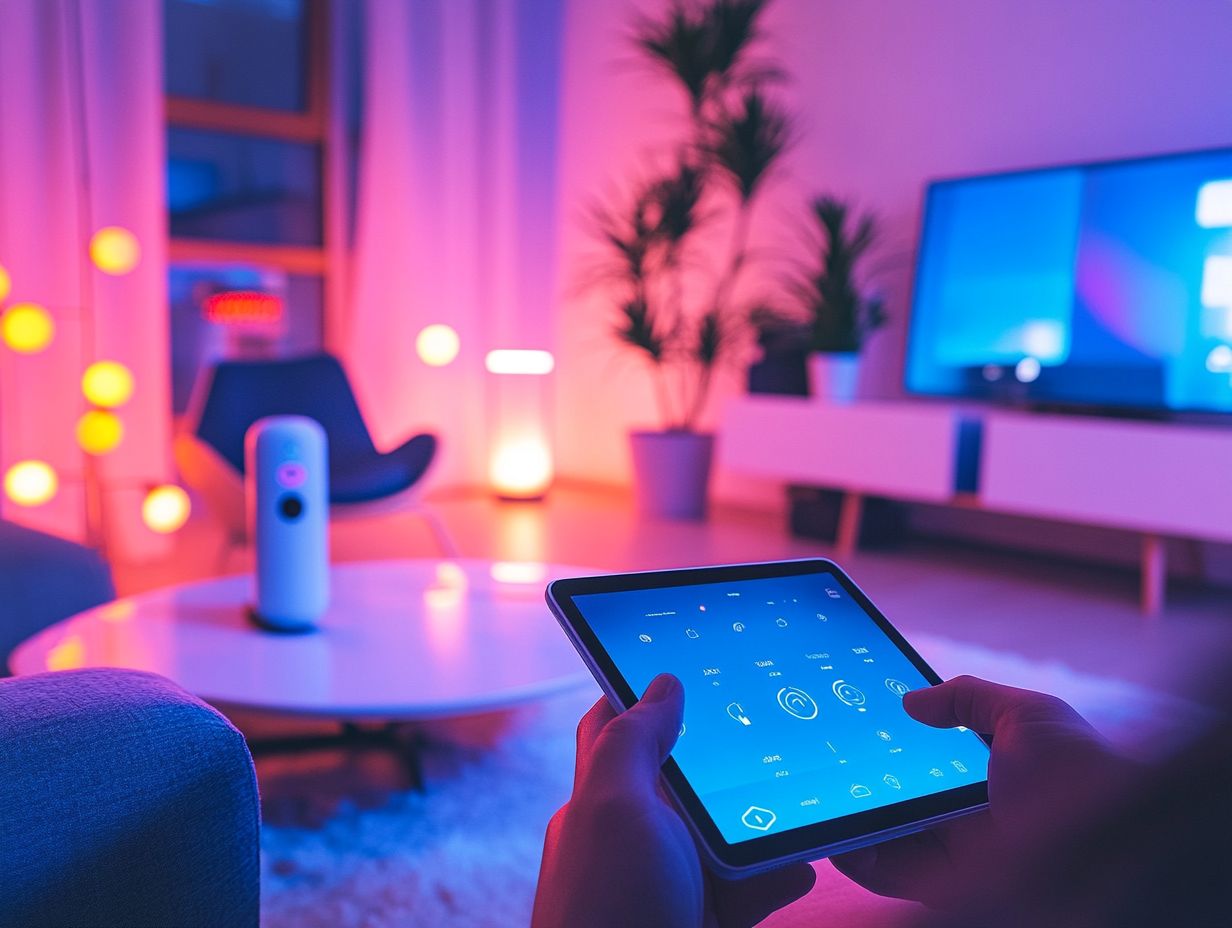Home automation is fundamentally changing how individuals interact with their living spaces, providing a harmonious integration of technology, convenience, and home monitoring that enhances daily routines. Just read on for your head start on How to Automate Your Home.
By incorporating smart lighting, climate control, and advanced security systems, automating a home can significantly improve efficiency while offering considerable cost savings. Additionally, integrating home assistants and smart thermostats ensures optimal temperature control and energy management.
It is beneficial to explore the numerous advantages of home automation, review the various automation systems available, and seek guidance in selecting the right setup tailored to specific needs, including smart home solutions and customizable settings.
Unlocking the full potential of a smart home can lead to a more comfortable and efficient living environment, enhanced by smart home integration and intelligent home technology.
What is Home Automation?
Home automation involves integrating technology into your living space to create a smart home environment that enhances both convenience and efficiency. By utilizing IoT devices, homeowners can remotely control various aspects of their homes, such as lighting, climate control, security systems, and entertainment features. This interconnectedness not only provides a seamless user experience but also promotes effective energy management, ensuring that the home operates more efficiently while aligning with a modern lifestyle.
At the heart of this concept are essential components like smart devices, which range from smart thermostats and lighting solutions to advanced security cameras and smart locks. Home networks play a crucial role in facilitating communication among these devices, enabling connectivity through protocols such as Zigbee and Z-Wave. These automation systems ensure that devices from different manufacturers can work together harmoniously.
A user-friendly interface is also vital, allowing homeowners to easily set up automation rules, automation workflows, and ensure compatibility across various devices. When these elements come together, home automation simplifies daily life and creates a tailored environment that adapts to individual preferences and needs.
Benefits of Automating Your Home
Automating your home can bring a wide range of benefits that significantly enhance daily living, from greater convenience to improved energy efficiency. By adopting smart home technologies, you can simplify everyday tasks, optimize your energy usage, and create a safer environment for your family.
Solutions such as smart lighting, smart thermostats, and automated curtains not only make your routine easier but also enhance your overall lifestyle by offering remote access, intuitive control, and integration with home automation apps.
Convenience and Efficiency
One of the primary advantages of home automation is the exceptional convenience it provides, including automated reminders and routine scheduling of smart devices.
With just a tap on a mobile app or a simple voice command through smart speakers, you can control everything from smart appliances to home security systems. This level of automation allows for routine scheduling of tasks such as automated lighting and smart thermostat adjustments, ensuring that your home operates efficiently without the need for constant manual oversight.
Integrating various smart devices, such as smart plugs that can activate or deactivate connected electronics, smart locks that offer keyless entry and enhanced security, and voice control features, significantly enhances this convenient lifestyle.
Home assistants equipped with advanced voice recognition technology offer an intuitive interface that enables users to manage these devices with ease. This user-centric design not only simplifies daily tasks but also fosters a more responsive living environment.
The seamless communication between devices creates a cohesive ecosystem that anticipates user needs, making modern living not only smarter but also more adaptable and user-friendly.
Cost Savings
Plus the convenience it offers, automating your home can result in significant cost savings through enhanced energy management, energy consumption tracking, and efficiency.
By utilizing smart energy meters and automated systems to monitor energy consumption, homeowners can pinpoint areas where they can minimize waste and reduce their utility bills. This makes smart home technology a prudent investment for the future.
Smart appliances that come with energy-saving features, such as programmable thermostats, smart lighting, and smart switches, provide greater control over usage patterns and home energy systems.
These advancements not only improve comfort but also encourage responsible energy consumption.
Over time, reducing energy waste leads to lower monthly expenses and can even increase property value. Additionally, smart grids and intelligent home technology play a significant role in sustainable home management.
As homeowners embrace these innovative solutions, they experience immediate savings along with the long-term financial benefits of having a more efficient and sustainable home environment.
Types of Home Automation Systems
When contemplating home automation, it’s essential to understand the various types of systems available, which can be broadly divided into wired and wireless technologies. Each of these systems presents distinct advantages regarding installation, scalability, and device compatibility.
Wireless technologies, such as Wi-Fi, Bluetooth, and Z-Wave, facilitate the seamless integration of various smart devices, allowing for a connected home without the necessity of extensive wiring. This includes smart home platforms and smart hubs that streamline device connectivity.
On the other hand, wired systems tend to offer more reliable connections, making them a strong option for certain situations.
Comparison of Wired and Wireless Systems
The difference between wired and wireless home automation systems primarily revolves around installation and connectivity. Wired systems necessitate physical connections, which often leads to more stable performance. On the other hand, wireless systems provide greater flexibility and ease of expansion. When deciding between these two options, it is important to consider factors such as home network security and compatibility with existing devices.
Wired systems may require a more labor-intensive and costly installation process due to the need for cable routing and potential retrofitting. However, they ensure robust home connectivity and system compatibility.
However, they generally offer longevity and reliability since they are less prone to interference. In contrast, wireless solutions can usually be set up quickly with minimal disruption, making them appealing for homeowners who wish to adapt or expand their systems over time.
Devices like smart thermostats and security cameras can work effectively in both wired and wireless environments. Additionally, smart smoke detectors and environmental sensors can further enhance home safety and monitoring.
However, users should prioritize robust encryption and regular software updates to address data privacy concerns that may arise with wireless technology. Evaluating the security protocols available in each system is essential, as vulnerabilities in wireless connections could expose sensitive information if not properly managed.
Choosing the Right Automation System for Your Home
Choosing the right home automation system involves thoughtful consideration of several important factors, such as your specific needs, budget, and the types of devices you want to integrate into your smart home ecosystem, including home entertainment systems and home automation kits.
It’s essential to understand how compatible these devices are with different automation platforms, as this will significantly influence the overall functionality and user experience of your automation system.
Factors to Consider
When assessing home automation systems, it is important to consider several factors that contribute to optimal performance and user satisfaction. Key aspects include the intuitiveness of the user interface, the availability of a comprehensive installation guide, and the ease of programming and setup for both tech-savvy individuals and those less familiar with technology.
Moreover, mobile app functionality has become essential in today s automation landscape, allowing users to control their devices remotely and receive real-time notifications.
This experience is further enhanced by alerts and notifications that keep homeowners informed about their property’s status, providing peace of mind whether they are at home or away.
Additionally, support for voice recognition technology and virtual assistants can significantly enhance accessibility and convenience, enabling users to issue commands with ease and integrate voice control into their daily routines.
By incorporating these specific features, automation systems can greatly improve the overall user experience, making daily interactions more seamless and efficient.
Installation and Setup
Regarding installing and setting up a home automation system, there are primarily two approaches one can take: DIY automation or professional installation. DIY projects can be supported by home automation apps and comprehensive installation guides.
Many homeowners prefer the DIY route to save on costs and gain some hands-on experience in the process.
On the other hand, some individuals opt to hire professionals, as this ensures a smooth installation and reliable performance of their smart devices, including home diagnostics and troubleshooting support.
DIY vs Professional Installation
When considering whether to pursue DIY automation or opt for professional installation, it is important to evaluate your own technical skills and comfort level in relation to the complexity of the system you are contemplating. For those who are tech-savvy, a DIY installation can be a fulfilling experience that allows for tailored home management using automation hubs and smart home systems. Conversely, others may find greater value in the expertise of professionals who can ensure that the setup is completed correctly and functions optimally.
Cost typically serves as a significant factor when comparing these two options. While DIY projects often save money on labor costs, it’s crucial to consider the potential expenses that may arise from mistakes made during the installation process, especially when dealing with complex automation systems and IoT devices.
Additionally, the time commitment involved in a DIY project can be considerable, as it often requires extensive research and trial and error, which may be frustrating for those lacking prior experience with home automation kits and automation protocols. For example, a homeowner who is comfortable with technology may successfully install smart lighting on their own. In contrast, a busy professional with limited technical skills might prefer to hire an expert who can efficiently install a comprehensive smart home system, alleviating any associated hassle. Professionals can also ensure system compatibility and optimal integration with existing home connectivity.
Automation Devices and Features
Benefits of Smart Home Automation
Smart home automation offers numerous benefits including enhanced convenience, improved energy efficiency, and increased home security. By leveraging wireless technology and connected devices, homeowners can enjoy a seamless living experience.
The variety of automation devices and features available today is extensive, allowing individuals to create a personalized smart home environment tailored to their specific needs and preferences.
With options ranging from smart lighting and thermostats to security cameras and smart appliances, these connected devices significantly enhance convenience, family safety, and energy efficiency within the home.
Smart Home Devices and Their Functions
Smart home devices play a crucial role in automating various aspects of your living space, ultimately enhancing both convenience and security. Devices such as smart locks, smart lights, smart plugs, and intelligent sensors allow for remote control and monitoring, enabling users to manage their home environment in a more effective manner. Smart blinds and smart mirrors further add to the convenience, providing innovative solutions for everyday tasks.
For example, with a smart thermostat, homeowners have the ability to optimize their heating and cooling systems according to their schedules, which can lead to significant energy savings and energy usage monitoring. When combined with smart lighting that can be programmed to adjust automatically based on the time of day, these devices not only promote comfort but also contribute to improved energy efficiency. Smart irrigation systems can also ensure that your garden is watered efficiently, further enhancing energy management.
Moreover, smart security cameras and motion detectors can easily work together with these systems, offering real-time surveillance and sending alerts directly to a homeowner’s smartphone through home automation apps. This interconnected functionality showcases how smart home devices enhance the overall living experience, working harmoniously to create a synchronized environment where innovation seamlessly blends with daily life.
Controlling Your Automated Home
Automation Control Methods
There are several methods to control your smart home, including voice control, remote access, and programmable devices. These methods enable users to customize their home automation experience.
Managing your automated home is a smooth and convenient experience, thanks to the various methods available for remote access and real-time management of your connected devices.
Whether you prefer using a mobile app, issuing voice commands through smart speakers, or utilizing automation triggers, you can effortlessly monitor and adjust your home settings from virtually anywhere. Advanced home monitoring solutions provide real-time insights, ensuring your home remains secure and efficient.
Methods for Controlling and Monitoring Your System
Integration and Multi-Device Control
Optimal integration and multi-device control are essential for a cohesive smart home experience. Home assistant compatibility ensures that all devices work together seamlessly.
There are several effective methods for controlling and monitoring a home automation system, including mobile applications, smart home platforms, and integrated voice assistants, such as virtual assistants, that facilitate hands-free operation. These solutions not only provide remote control capabilities but also offer advanced monitoring and alerts, ensuring that homeowners remain informed about their security and energy usage.
Examining each method more closely reveals a variety of features designed for user convenience. Mobile applications typically feature intuitive interfaces, allowing users to adjust settings, set schedules, and receive real-time notifications and alerts regarding any unusual activities. Smart home platforms integrate various devices seamlessly, making it easier to manage everything from lighting to HVAC systems through a single interface. Voice assistants further enhance usability by enabling users to issue verbal commands for instant operation.
When these systems work in harmony, they create a cohesive smart home environment. The integration of cloud services allows for enhanced data management and home diagnostics, further improving the user experience.
This effective monitoring not only improves the overall user experience but also strengthens home security by providing constant insights into what is happening around the house.
Potential Challenges and Solutions
Home automation provides many advantages, but homeowners may face certain challenges, which can include technical difficulties as well as concerns regarding data privacy and security.
By recognizing these challenges and implementing effective solutions, homeowners can ensure a smooth and satisfying experience when integrating smart technology into their living spaces.
Common Issues and How to Address Them
Common issues in home automation systems often involve connectivity problems, concerns regarding device compatibility, and challenges with automation software, all of which can hinder the user experience. It is important to address these issues promptly and effectively to maintain a seamless smart home environment.
To troubleshoot connectivity problems, one should begin by checking the strength of the Wi-Fi signal and ensuring that the devices are within range of the home network and router. Restarting both the router and the smart devices can also be beneficial, as this action refreshes their connections.
In the case of device malfunctions, users should verify that their automation software is up to date, since updates frequently include important bug fixes. Exploring manufacturer support resources can provide valuable insights, and community forums and home automation trends may offer tips from fellow users who have encountered similar challenges.
This collaborative approach can ultimately enhance the problem-solving process.
Frequently Asked Questions
How to automate my home using smart devices?
There are many smart devices available in the market, such as smart plugs, thermostats, lights, and security systems, that can be connected to a central hub or controlled via a smartphone app to automate your home. Simply set up the devices and connect them to your hub or app, and you can easily control and automate them to make your home more efficient and convenient.
What are the benefits of automating my home?
Automating your home can bring many benefits, such as improved energy efficiency, increased convenience, enhanced security, and cost savings. With smart devices, you can schedule and control your home’s functions remotely, making your life easier and more comfortable.
How can I control my automated home when I am away?
Most smart devices and hubs come with a smartphone app that allows you to control and monitor your home from anywhere. As long as you have an internet connection, you can easily access and control your automated devices to make sure everything is running smoothly.
Do I need any technical skills to automate my home?
No, you do not need any technical skills to automate your home. Most smart devices and hubs are designed to be user-friendly and easy to set up. You can also find plenty of online tutorials and guides to help you with the installation process.
What types of tasks can I automate in my home?
You can automate a variety of tasks in your home, such as turning on/off lights, adjusting the thermostat, locking doors, and even starting your coffee maker in the morning. The possibilities are endless, and you can customize and control your home’s functions according to your needs and preferences.
Is automating my home safe and secure?
Yes, automating your home is safe and secure. Most smart devices and hubs use advanced encryption and security protocols to protect your data and prevent unauthorized access. You can also set up additional security measures, such as two-factor authentication, for added protection.










